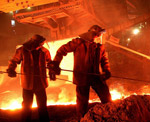The customs committee of Armenia has published the report 2011, which shows how impressive “data” had been registered.
Before the report would be published the National Statistics Service had published information concerning the external trade, showing that the export had grown by 27.7%, and the import – by 10.7%. According to the mentioned statistical information, in 2011 the export was around 1.33 billion dollars, and the import – 3.74 billion. The negative balance of foreign trade is huge – 2,182 billion dollars. However, the government is not concerned about this gap. They prefer focusing on the tendencies. This means that they think that even though the negative balance of foreign trade is huge, it is developing and if it continues developing like that, the gap will be closed soon or late. However, many people believe there is no reason to be happy about the export growth at 27.7% as it was mainly due to the mining sector and growth of prices on metals. However, the government did not stop on that and started to praise this growth more, assuring that it would help Armenia become a country that is mostly focused on export.
Now let’s go back to the information of the customs committee. In difference with the information published by the National Statistics Service, the customs service statistics shows mainly information on separate types of products. These data enable calculating the inflation factor. This can show how much the role of inflation has been in the export growth.
The chart below is made based on the export information of products that have higher customs prices. Meantime, we have taken only metals.
Comparing the data for 2011 and 2010 we see that the export itself has really grown. However, prices have grown faster. For example, the export of copper has grown by 2%, but the price per ton has grown by 21%.
As a result, the export rate has grown by 23.7%, i.e. from 210.6 to 260.5 million. How much would be the rate of copper mine stone if the price did not change compared to 2010? The last raw of the chart is giving the answer to this question – 214.9 million. In other words, in the last raw we have indexed the export by reducing the factor of inflation to zero. As a result, the export of 11 groups of products has reduced from 725.3 to 642 million. This means that inflation only for these 11 groups of products has generated a rate of 83.3 million dollars growth. Certainly this cannot be considered natural growth. Similar calculations can be dene for other types of products as well. It is not excluded that such calculations will bring to a conclusion that if we take out the factor of inflation, the real growth in export is close to zero.
The customs statistics shows another weird thing too. Only the export of metals for these 11 groups of products is more than the half of the entire export capacity. The entire export consists of 852 types of products, which amounted 1.33 billion dollars in 2011. This means that our export direction is sick and mainly depends on the mining sector export (for metals mainly). The government acknowledges this fact too and commits to change the configuration of the economy to foster local production. It is a fact that since 2009 the government has been speaking of the lessons learnt from the crisis and the importance to limit the role of the mining sector export. There should have been some improvement in this direction during the past two years.
It is not difficult to check it. If we calculate how much was the share of the mentioned 11 types of products in export during the past years, it will become clear whether anything has been done to change the situation with the export. In 2011 the share of those products in the export capacity was 54%. In 2010 it was 58.6%, which means that there is a positive tendency since 2010.
However, when we go back to the previous year, the picture is changing. In 2009 the share of the 11 types of products in the export capacity was 50.1%. In 2007 and 2008 it was 48% and 46.3% accordingly. It means that the export configuration is sicker now than before the crisis. This is dangerous already. If we take into consideration the possible stagnation of the world economy (the Euro zone specifically), we will see that our economy is more vulnerable now than in 2008-2009.

